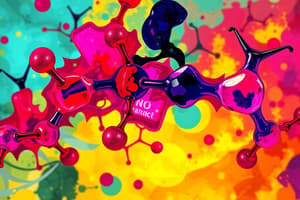Podcast
Questions and Answers
What is the main function of hemoglobin?
What is the main function of hemoglobin?
- Transport of oxygen in blood (correct)
- Storage of carbon dioxide in muscle
- Transport of carbon dioxide in blood
- Hydroxylation of xenobiotics
Hemoglobin can pass through capillary membranes.
Hemoglobin can pass through capillary membranes.
False (B)
What are the two types of chains in a hemoglobin molecule?
What are the two types of chains in a hemoglobin molecule?
alpha and beta chains
Hemoglobin consists of ___ alpha chains and ___ beta chains.
Hemoglobin consists of ___ alpha chains and ___ beta chains.
What molecule can enter red blood cells, release its ribose moiety, be phosphorylated, and eventually be converted to 2,3-BPG?
What molecule can enter red blood cells, release its ribose moiety, be phosphorylated, and eventually be converted to 2,3-BPG?
Which gas binds to hemoglobin 210 times more readily than oxygen?
Which gas binds to hemoglobin 210 times more readily than oxygen?
Methemoglobin carries a positive charge and can combine with neutral atoms such as O2, CO2, or CO.
Methemoglobin carries a positive charge and can combine with neutral atoms such as O2, CO2, or CO.
Myoglobin serves as an intracellular storage site for ____ in muscle tissue.
Myoglobin serves as an intracellular storage site for ____ in muscle tissue.
Match the following substances with their role in the body:
Match the following substances with their role in the body:
Flashcards are hidden until you start studying
Study Notes
Here are the study notes:
Porphyrins
- Porphyrins are cyclic compounds formed by the linkage of four pyrrole rings through methenyl bridges (-HC=)
- Porphyrin rings are numbered with Roman numerals I through IV, starting at the top and proceeding clockwise
- Methenyl bridges are lettered with Greek letters, alpha through delta, again proceeding clockwise
- Common substituents are often abbreviated, e.g. A = acetic acid, P = propionic acid, M = methyl, V = vinyl
Hemoproteins
- Hemoproteins are proteins that contain heme (iron-protoporphyrin)
- Examples of hemoproteins in humans and animals:
- Hemoglobin (Hb) in red blood cells (RBCs)
- Myoglobin (Mb) in muscle tissue
- Cytochrome c in electron transport chain
- Cytochrome P450 in xenobiotic metabolism
- Catalase in hydrogen peroxide degradation
- Tryptophan pyrrolase in tryptophan oxidation
Hemoglobin (Hb)
- Hemoglobin is the key molecule of oxygen transport
- It is the main constituent of RBCs and responsible for the red color of blood
- Hemoglobin has a large molecular weight and is electrically neutral
- Normal blood concentration of Hb is 12-16 gm/dL (female) and 14-18 gm/dL (male)
- Hemoglobin carries oxygen from lungs to tissues and carbon dioxide from tissues back to lungs
Hemoglobin Structure
- Hemoglobin molecule consists of four polypeptide chains: two alpha chains and two beta chains
- Each chain has a heme molecule containing a ferrous iron atom
- The protein portion of each chain is called globin
- Alpha and beta globin chains are very similar in structure, but distinct from each other
- Histidine residues in the globin chains form a fifth coordination bond with the heme iron ion
Types of Hemoglobin
- Embryonic Hb (a2e2)
- Fetal Hb (a2g2)
- Adult Hb (a2b2)
Functions of Hemoglobin
- Oxygen transport (oxy Hb)
- Carbon dioxide transport (carbamino Hb)
- CO transport (carboxy Hb)
Oxygen Binding to Hemoglobin
- Iron is displaced from one imidazol ring and one oxygen is attached instead
- Each Hb subunit contains a pocket for the heme that provides a non-polar environment for oxygen binding
Bohr Effect
- Decreased oxygen affinity of Hb in tissues due to high CO2 and H+ concentrations
- CO2 is transported as bicarbonate, formed by the enzyme carbonic anhydrase
- Protons generated from CO2 and water react with Hb, lowering its oxygen affinity
- In lungs, high oxygen concentration and low CO2 and H+ concentrations increase oxygen affinity of Hb
2,3-Diphosphoglycerate (2,3-DPG)
- A metabolite found in the anaerobic glycolysis pathway
- Binds to partially deoxygenated Hb, reducing its oxygen affinity
- Increases in response to chronic hypoxia or anemia
- Essential for the normal oxygen transport function of Hb
Carbon Monoxide (CO)
- A byproduct of incomplete combustion of fuels
- Has a 210 times greater affinity for Hb than oxygen
- Displaces oxygen from Hb, inhibiting oxygen transport
- Can cause carbon monoxide poisoning
Methemoglobin (MetHb)
- Formed when the iron of Hb is oxidized to the ferric state
- Cannot combine with oxygen, CO2, or CO
- Can be reduced back to Hb by MetHb reductase in the presence of NADPH
- Cyanide toxicity can be treated with sodium nitrite, which oxidizes some Hb to MetHb, which then reacts with CN- to form a non-toxic compound
Studying That Suits You
Use AI to generate personalized quizzes and flashcards to suit your learning preferences.




